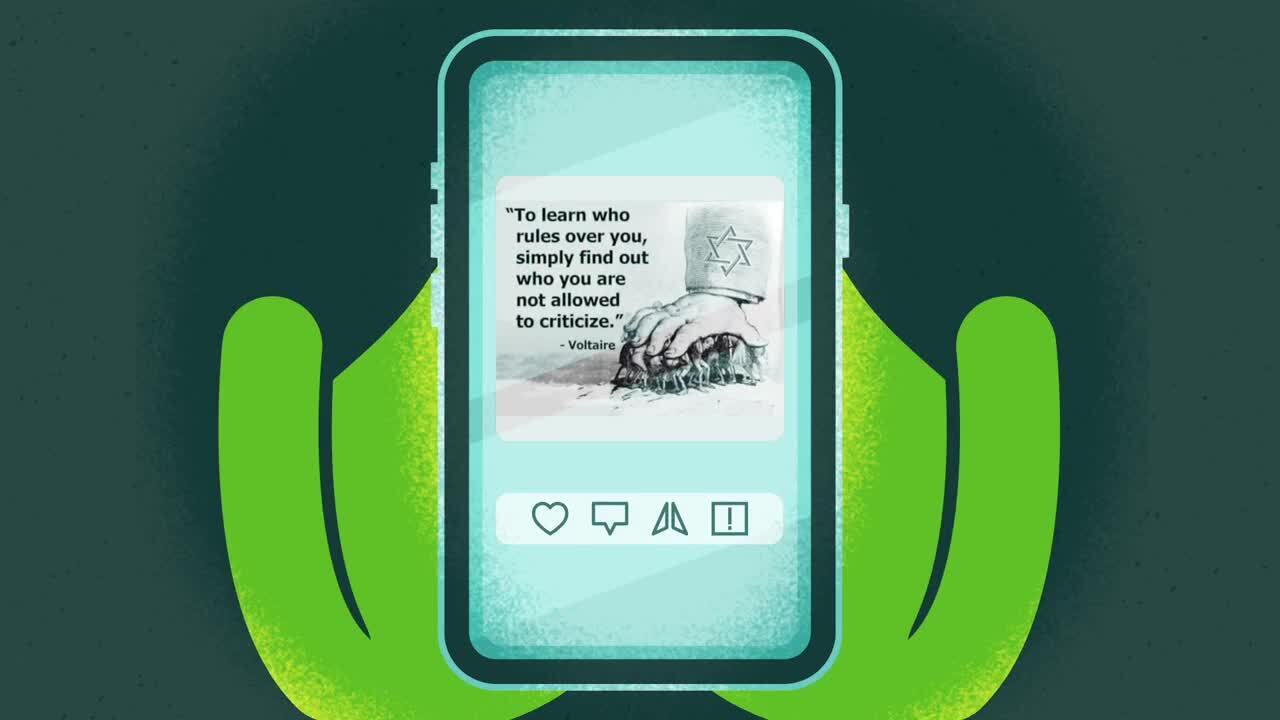Memes have become a social media phenomenon. They are images that are intended to carry a particular message, oftentimes, conveyed in a funny way so you will quickly share them with your friends. They are packed with symbols and coded language, and increasingly, they have become tools to spread hate online, such as racist and antisemitic ideas.
Memes can offer simplified solutions to very complex problems, problems with nuance and long histories. And if you have heard a stereotypical idea about Jews, antisemitic memes will often reinforce that idea. There are about seven antisemitic tropes that we see being packaged and repackaged consistently in social media spaces-- blood libel, global domination, power and conspiracy, replacement theory, disease and filth, deicide charge, wealth and greed, Holocaust denial, and distortion.
In this particular image, there's a hand with the Star of David, a prominent Jewish symbol, over a group of people who are being suppressed or controlled by that hand. This is coded language to suggest that Jews are in control. The quote is saying that if you want to know who rules over you, who has power and control over you, you need to know who you cannot criticize. This is tapping into the antisemitic trope of global domination, power and conspiracy, a trope that claims Jews are part of a global conspiracy to dominate the world.
The meme is being presented as an intellectual idea because it's coming from Voltaire, who we associate with the Enlightenment values of knowledge, freedom, and reason, but it's not true. Voltaire never said this. In fact, a noted white supremacist and Holocaust denier said it. The elements of the meme were put together to create a single fabricated antisemitic message. This meme appeals to the emotions of people who have a desire to push against authority it suggests that people who are intentionally preventing them from having free speech are the Jews.
This image is intended to draw on an old image that is very popular in a lot of high school history textbooks. It is a reference to the European colonial distribution of Africa at the Berlin Conference in 1885. The image is intended to speak about colonialism and the extraction of resources out of Africa, but it is problematic in multiple ways.
First of all, the state of Israel, which is at the table with Britain and France, did not even exist in the 19th century. So Israel cannot be a part of a conversation about the colonization of Africa. But why is it here? It's intended to make a comment about Israel as a modern colonial power. It's making a statement about the geopolitical Middle East conflict between Israel and the Palestinians but in a very sophisticated nuanced way.
Unless you have a deep knowledge of history, of Africa, of colonialism, of 19th century European nations, and of Israel's founding in 1948, you would not know how to unpack this image. This meme is inviting an emotional reaction. Even if you don't know the history of colonialism, you may have heard and generally agree that colonialism is bad. So this image is associating Jews in the state of Israel was something you may already consider bad.
The other symbol here is of Africa as a bloody steak, a reference to the antisemitic trope of the blood libel. The blood libel trope refers to the false allegation that Jews use the blood of non-Jewish, usually Christian children, for ritual purposes. What will stick with you from this meme is the steak, the blood. The idea here is that countries, including Israel, are feeding on Africa's blood, its Black citizens, which is false.
This image was popular with the spread of COVID during the pandemic. There are a lot of antisemitic tropes packed into this particular image. You see global domination, disease and filth, power and conspiracy. This image draws on a lot of old Nazi ideas about Jews around the world infiltrating non-Jewish communities to spread disease and filth.
This meme was intended for people who do not have enough scientific background to understand the spread of viruses. It showed up in the feeds of people who were trying to understand the origin of the COVID-19 virus. It takes an image that many young people would be familiar with, the image of the Trojan Horse in The Odyssey. The image is asking young people to make the transference from the story of the Trojan Horse to what is happening today. It is intended to fill holes in knowledge by tapping into something you think or you've seen somewhere before.
The image gives you a simple answer to a very complex problem. It's telling you, here are the people to blame or who's really behind this problem. It's the Jews. They are part of a global conspiracy to spread disease. And if you've heard something about distrusting Jews, this meme will affirm a young person's antisemitic ideas and stereotypes.
The critical analysis of these images that we've just done is not usually what happens when young people see memes. Memes are intended to be consumed very quickly and shared on social media. The danger of these memes in an online space is that they are repackaging old antisemitic ideas and stereotypes about Jews but in a modern format that can be spread in a viral way. When you are receiving these memes from friends, family members, or people you trust, you're not in a space where you are likely to critically analyze them. One of the ways you can equip yourself to combat racism and antisemitism online is by helping to stop the spread of memes like these.
So when these images come across your social media feed, don't share them. Instead, slow down, analyze and question them, why was this meme created? What is the meme trying to convey? What does this meme want me to do? Who does this image want me to dislike? Who is this image intending for me to be afraid of?
Once you're able to identify the bigotry or racism in an online meme, you can use the reporting feature on any social media platform to alert the platform's moderators. Each of us can contribute to making our social media spaces safer and free of hate-fueled messaging by taking these steps.














